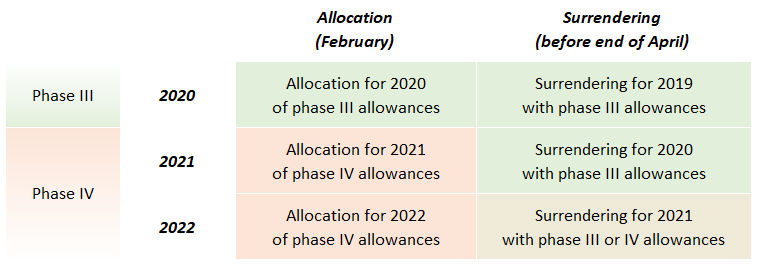Phase IV of the EU-ETS (2021-2030)
Emission allowances (EUA and AEUA) allocated in phase IV (from 1 January 2021 onwards) cannot be used in the current phase. All current general (EUA) and aviation (EUAA) allowances remain however valid.
Transition to phase IV
Phase IV starts on January 1, 2021. The first free allocation of phase IV allowances is planned for February 2021. However, in April 2021 the emissions of the last year of phase III (2013-2020) still have to be compensated. The compensation for 2020 emissions must be achieved by surrendering phase III allowances.
Some companies use the allowances allocated in February to surrender them in April that same year. This is not possible in the transition from phase III to phase IV, as phase IV allowances are not valid in phase III. The registry will therefore not allow surrendering of phase IV allowances to compensate for emissions of the year 2020 (which must be effectuated no later than April 2021). Companies and aircraft operators that have to surrender allowances for 2020 must therefore ensure sufficient allowances from phase III.
The emission allowances obtained via the auction from 1 January 2021 will be phase IV emission allowances. Therefore, these allowances cannot be used to compensate emissions of the year 2020.
If you purchase emission allowances via third parties (for phase III compliance), it is of utmost importance to check whether they are phase III or phase IV allowances.

Validity of allowances
The current general (EUA) and aviation (EUAA) allowances automatically remain valid in phase IV (2021-2030) ; you do not need to take any action for that.
As indicated above, the reverse is not the case : phase IV emission allowances (EUA and AEUA) cannot be used for compliance in phase III.
At least until 1 May 2021, phase IV emission allowances will have a phase indication.
Use of aviation allowances (EUAA) by fixed installations
From phase IV onwards, aviation allowances (EUAA) can also be surrendered by fixed installations. Both types of allowances (EUA and EUAA) can therefore from then on be used by both fixed installations and aviation operators for their compliance obligations.
In practice, this means that from the start of phase IV onwards (January 1, 2021) operators of fixed installations will also be able to hold EUAAs on their operator holding account (this is not possible for the moment). However, they can use these EUAAs only for compensation of emissions in 2021 or thereafter.
The first surrender deadline of emission allowances for phase IV is 30 April 2022 (compensation for emissions in 2021) and that will therefore be the first time that EUAAs can be used for compliance by operators of fixed installations.
As indicated above (validity of allowances), the EUAAs - like the EUAs - used for compliance in phase IV can be either allowances created in phase III or allowances created in fase IV.
Use of international credits (CER / ERU) in phase IV
CERs and ERUs can no longer be used in phase IV of the EU ETS.
If you have a remaining credit entitlement, you can exchange purchased CERs or ERUs until the end of April 2021 into phase III allowances (EUA / AEUA).
From 1 May 2021, incoming transactions with CERs / ERUs to EU accounts (EU-100 -...) are no longer possible. Any CERs / ERUs that are on the accounts can still be held though until July 1, 2023.
Implementation of phase IV in the registry
From January 1, 2021 a lot of changes will be made to the registry software (including additional data fields and changed functionality) :
Accounts & compliance
- The compliance figures - positive or negative - are carried over into Phase IV.
- Operator Holding Accounts (OHA) will be able to hold - as from 1/1/2021 - and surrender - as from 1/5/2021 - aviation allowances (EUAA).
- Person Holding Accounts (PHA) will be migrated automatically into Trading Accounts (TA).
(Additional) Authorised Representatives (A)ARs & their roles
- Authorised Representatives (AR) can act in one of the four different roles below on an account :
- 1. Read only
- 2. Initiate transactions
- 3. Approve transactions
- 4. Initiate or approve transactions
- The migration of ARs and AARs to the new roles on their account(s) happened automatically :
- If an AAR was nominated : ARs will be migrated into role 2 (Initiate transactions), AARs into role 3 (Approve transactions).
- If no AAR was nominated : ARs will be migrated into role 4 (Initiate or approve transactions)
- No change for ARs with read-only access, they remain in role 1.
Transactions & Trusted Account List (TAL)
- Transactions effectuated to an account outside the TAL, if allowed, will be completed :
- At 12 CET the next working day, if approved before 12 CET on a working day.
- At 12 CET the second next working day, if approved after 12 CET on a working day or at anytime not on a working day.
- Adding an account to the TAL will become effective the fourth working day at 12 CET after confirmation by a second AR.
- Transactions or changes to the TAL will need to be effectuated by two ARs by default :
- 1. Initiated by an AR with an initiator role (2 or 4).
- 2. Approved by an AR with an approver role (3 or 4).
- At the initiation of each transfer, an AR is required to indicate whether the transfer represents an over-the-counter trade executed between two entities without any intermediaries (bilateral transaction).
More information can be found in the specific FAQ published by the European Commission : https://ec.europa.eu/clima/policies/ets/registry_en#tab-0-2
[Back to the top of this page]